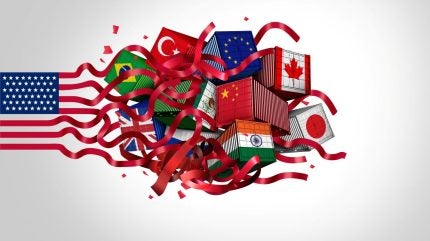Global fashion supply chain braces for impact as Trump tariffs go live

GLOBAL FASHION SUPPLY CHAIN BRACES FOR IMPACT AS TRUMP TARIFFS GO LIVE
Global
apparel supply chains are about to see significant upheaval – again – as US
President Trump’s tariffs go live.
China, the largest fashion supplier to the US, and the world, has been hit with an eye-watering 104% duty on almost all imports as a result of the Trump tariffs.
Trump introduced the additional 50% duty on
US imports from China after Beijing refused to withdraw the 34% tariff it
imposed on US products last week.
However, China’s exports to the US amount to 2% of its total economic activity with the BBC reporting that Beijing’s message to the world is that it can ride it out.
Trump’s list of reciprocal tariffs came into effect on 9 April and will impact many other major fashion sourcing countries, including Vietnam, Bangladesh, Cambodia and India.
US fashion, textile and retail trade bodies have warned US consumers are likely to bear the brunt of the decision.
Speaking to Just Style exclusively, Mark Burstein, SVP Americas, at supply chain management firm Inspectorio explained it found after speaking with a number of fashion supply chain executives that many companies are exploring four Trump tariff “coping strategies.”
1. Partnering with key suppliers to share cost burdens – absorbing some tariffs while selectively adjusting prices but not pursuing production relocation.
2. Exploring shifts to alternative sourcing countries with lower tariff exposure – this includes expanding production with current partners in those countries and actively identifying new supplier options.
3. Adopting a more agile, Just-in-Time Sourcing model – positioning materials strategically and shipping smaller quantities more frequently to stay responsive to potential tariff changes.
4. Forming a dedicated sourcing task force to identify products that can be manufactured in the US.
Burstein added: “The additional 50% tariff on China will greatly affect the companies evaluating the first strategy for their products made in China, so I expect that most of them are also putting more effort into assessing the second strategy.”
The United States Fashion Industry Association (USFIA) said earlier: “The fashion industry depends on global supply chains more than perhaps any other sector of manufactured goods. For instance, a bale of cotton might be grown in Texas, shipped to Europe to be spun into yarn, sent to Korea for fabric production, then to Vietnam for garment assembly, and finally to the US for retail sale — back in Texas. Additionally, these garments may be sold not only in the US but also in global markets such as Singapore, Japan, Dubai, or London.”
While the American Apparel and Footwear Association (AAFA) pointed out: “Before the so-called ‘Liberation Day,’ the average tariff on clothes, shoes, and accessories, which are necessities every American must buy, was already more than five times higher than on other US imports. True liberation would have involved eliminating this high tariff burden and relieving US consumers of its regressive and misogynistic effects, rather than layering on more costs that fuel inflation.”
